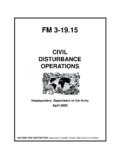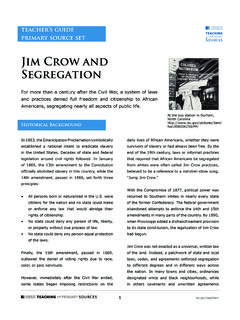Transcription of CONVERGENCE OF CIVIL L C L C S F - Julian Hermida
1 1 CONVERGENCE OF CIVIL LAW AND COMMON LAW CONTRACTS IN THE SPACE FIELD Julian Hermida * This article explores the evolution of CIVIL law and common law towards CONVERGENCE , briefly addressing the history of the theoretical and philosophical perspectives that contributed to shape evolution and change within these two systems. The article analyses general features of the central aspects of contract theory in CIVIL law and common law jurisdictions. As an example of CONVERGENCE in the commercial contract realm, the article focuses on the analysis of the structure, characteristics and main clauses of the commercial space launch services agreements in both systems, stressing their similarities in structure, treatment and consequences. Introduction Common law and CIVIL law contracts have been traditionally seen as distinctive and fairly Each belongs to a tradition that has been regarded as quite However, in several areas common law and CIVIL law have been increasingly marching toward The purpose of this article is to show that commercial space agreements constitute an area where there is a clear CONVERGENCE between these two systems.
2 Underlying this premise is our conception that despite the view of the majority of authors, common law especially as applied in the United States and CIVIL law should be considered as one legal tradition, ie the so called western legal In other words, the similarities of CIVIL law and US common law vis- -vis other legal traditions outweigh their This is especially visible in the commercial contract realm, where the selected contracts are but one example. And even in those areas where there are still striking differences both systems are slowly heading toward * Assistant Professor, Dalhousie University; Postdoctoral Fellow, University of Ottawa (2001 2002), Doctor of CIVIL Law (McGill University). The author would like to thank the University of California, Davis School of Law, particularly Beth Greenwood, and the Lauterpacht Research Centre for International Law of the University of Cambridge, Faculty of Law, where research for this article took place.
3 1 Glenn, , Are Legal Traditions Incommensurable? (2001) 49 Am J Comp L 133; Merryman, , The CIVIL Law Tradition: An Introduction to the Legal Systems of Western Europe and Latin America (Stanford: Stanford University Press, 1985), p 1. 2 Rua, C. and Cesar, J., The Future of the CIVIL Law (1977) 37 La L Rev 645. 3 Gordley, J., The Philosophical Origins of Modern Contract (Oxford: Clarendon Press, 1991), p 1. 4 Rene, D. and Brierley, , Major Legal Systems in the World Today (London: Stevens & Sons, 3rd edn, 1985), p 25. 5 Rene, D., Existe-t-il un droit occidental? in Kurt H. Nadelmann, Arthur T. von Mehren and John N. Hazard (eds), XXth Century Comparative and Conflicts Law: Legal Essays in Honor of Hessel E. Yntema (Leiden: Sijthoff, 1961), p 56. 6 See Gordley (n 3 above), p 1. 2 This article starts by examining the evolution of CIVIL law and common law toward CONVERGENCE , briefly addressing the history of the theoretical and philosophical perspectives that contributed to shape evolution and change within these two systems.
4 Then, the article analyses general features of the central aspects of contract theory in the CIVIL law and common law jurisdictions. Finally, this work focuses on the analysis of the structure, characteristics and main clauses of the commercial space launch services contracts in both systems, stressing their similarities in structure, treatment and consequences. The findings of this work are expected to shed some light on future research on other areas where CIVIL law and common law also present a high degree of CONVERGENCE Comparative Law has long been concerned with CONVERGENCE between legal CONVERGENCE constitutes the evolution of the legal institutions of different legal systems where the legal institution of one system resembles the other and the legal norms, principles, and scholarly comments of both are used in equal measure and even regarded with equal Unlike harmonisation, which implies a deliberate and negotiated process aimed at producing a legislative or other conventional act, CONVERGENCE constitutes a natural, or unconscious.
5 Common development of legal institutions through mutual Natural CONVERGENCE is the result of a tendency in similar nations to have similar problems and to arrive at similar ways of perceiving and dealing with It is postulated that this is the case in the law dealing with commercial space launch services contracts. However, this is the culmination of a phenomenon of CONVERGENCE which widely exceeds the area of commercial space It is not an isolated instance, but rather the natural route that CIVIL law and common law have been CONVERGENCE between areas of common law and CIVIL law is not It traces its roots to the Enlightenment and has been a slow and gradual In England the Inns of Court planted the first seeds of the process of integration between common law and CIVIL law in the early sixteenth century. Inspired by Roman law concepts, Littleton, Blackstone and other comparative scholars produced seminal works which also helped toward this, still slow, As emphasised by Glenn, by the nineteenth century 7 Hendler, , Derecho Penal y Procesal Penal de los Estados Unidos (Buenos Aires: Ad Hoc, 1996), p 36.
6 8 Duca, D., A Historic CONVERGENCE of CIVIL Law and Common Law Systems Italy s New Adversarial Criminal Procedure System (1991) 10 Dick J Int l L 73. 9 De Cruz, P., A Modern Approach to Comparative Law (Deventer: Kluwer, 1993), p 34. 10 Carol Harlow, Voices of Difference in a Plural Community (2002) 50 Am J Comp L 339, 342. 11 Merryman, , On the CONVERGENCE (and the Divergence) of the CIVIL Law and the Common Law (1987) 17 Stanford J of Int L 357. 12 See Gordley (n 3 above), p 134. 13 Stevens, D. and Neyers, , What s Wrong with Restitution? (1999) 37 Alberta L Rev 221. 14 Schadbach, K., The Benefits of Comparative Law: A Continental European View (1998) 16 B U Int l L J 331. 15 Glenn, , Legal Traditions of the World (New York: Oxford University Press, 2000), p 226. 16 See Schadbach (n 14 above), p 331. 3 English thought had developed a large measure of compatibility,17 which was later reinforced with the advent of the European In the United States, this process has been more remarkable and Highly respected authors have even suggested that US law represents a deliberate rejection of common law principle, with preference being given to more affirmative ideas clearly derived from CIVIL law.
7 20 While this affirmation may seem rather extreme, the United States was undoubtedly greatly influenced by CIVIL law sources in the nineteenth century, especially by German scholars, whose influence moulded the shape of US common This was evident in substantive law, especially in the reception of ideas of rights, virtually unknown at the time in the United Kingdom, but even more evident in terms of structures and sources of Legislation in the United States has also been influenced by CIVIL Apart from the obvious adoption of codes, courts often interpret legislation by resorting to civilian methodologies under a CIVIL law Specifically, in contract law the whole concept of adhesion contracts25 was directly taken from France, especially from Salleilles, a nineteenth-century French Interestingly, as observed by Glenn, these CIVIL law phenomena are often exported back to Europe and the rest of the CIVIL law world in decanted common law At the same time, common law ideas, styles and conceptions have greatly influenced CIVIL law.
8 Many CIVIL law jurisdictions have a statute law that is heavily influenced by common Entire legal areas, such as the regulation of securities, commercial papers and even constitutional law have been extrapolated from the United States to several CIVIL law countries29 and courts around the world heavily rely on US 17 See Glenn (n 15 above), p 226. 18 Levasseur, , Scott, , The Law of the European Union: A New Constitutional Order (Durham: Academic Press, 2001), p 1. 19 An interesting phenomenon of the CIVIL law influence in US procedure law is the apparently increasingly common practice of American appellate courts to publish slip opinions with a warning that the opinions are not to be cited. This behaviour, viewed systemically, might represent a retreat from stare decisis, and perhaps even a movement toward continental-style adjudication.
9 Bhala, Raj, The Myth about Stare Decisis and International Trade Law (1999) 14 Am U Int l L Rev 845. 20 See Glenn (n 15 above), p 230. 21 German scholars, such as Kessler and Ehrenzweig played an important role in the development of US contract law. Siegelman v Conard White Star Ltd F 2d 189, 204 205 (2nd Circuit, 1955). 22 See Glenn (n 15 above), p 230. 23 Frank, J., Influence of CIVIL Law in Common Law (1956) Pennsylvania Law Review 1. 24 Stone, , The Common Law in the United States (1936) 50 Harv L Rev 13. 25 An adhesion contract is a standardised contract drafted by only one party where the other party s only choice is to adhere to it or reject it. The weaker party, in need of the goods or services, is frequently not in a position to shop around for better terms, either because the author of the standard contract has a monopoly (natural or artificial) or because all competitors use the same clauses.
10 His contractual intention is but a subjection more or less voluntary to terms dictated by the stronger party, terms whose consequences are often understood in a vague way, if at all. Kessler, Friedrich Contracts of Adhesion Some Thoughts About Freedom of Contract (1943) 43 Colum L Rev 629, 632. 26 See Frank (n 23 above), p 1. 27 See Glenn (n 15 above), p 230. The US also exports these phenomena to Canada and England and thus these countries are also shaping their common law structure. 28 Tetley, W., Mixed jurisdictions: common law vs CIVIL law (codified and uncodified) (2000) 60 La L Rev 677. 29 Henkin, L., Constitutionalism and Human Rights in Louis Henkin (ed), Constitutionalism and Rights (1990) 392 395. 4precedents to reach their Additionally, a mosaic of common law institutions, such as probation as an alternative to punishment for criminal conduct, cramdown procedures for the approval of bankruptcy plans, class actions for collective litigation, and transfer pricing for the taxation of related companies have been introduced in CIVIL law countries directly from the United Furthermore, the United States also greatly influenced the structure and organisation of the legal profession and more and more countries now have a bar that resembles the US model.









